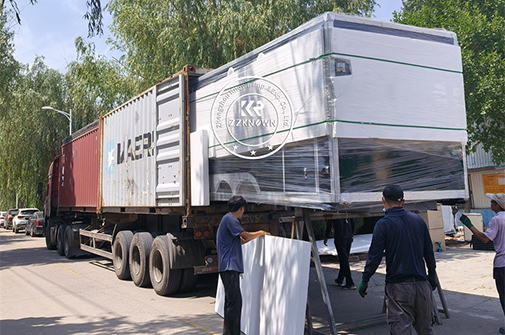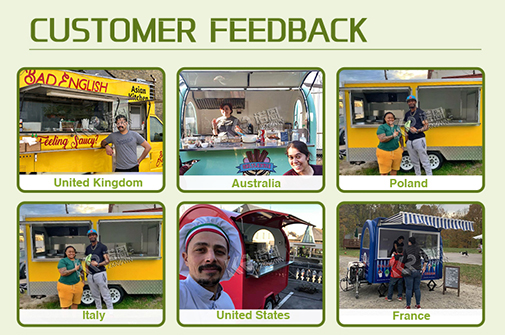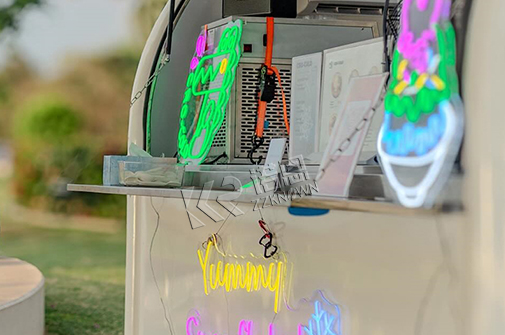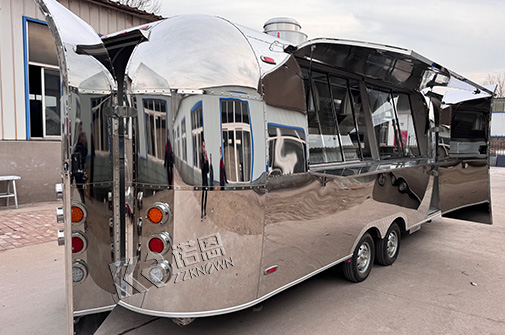The first step in purchasing a food truck is defining your concept. This is the foundation of your business and influences the type of vehicle, equipment, and layout you’ll need. Consider the following aspects when determining your food truck concept:
Menu & Cuisine Type: The dishes you plan to serve will determine the equipment and layout. For instance, a pizza truck may require a commercial pizza oven, while an ice cream truck needs freezers and cold storage.
Target Audience: Understand your target market’s preferences. Are you catering to a quick lunch crowd, or is your focus on specialty cuisine for food festivals? Your truck’s layout, serving speed, and design should reflect these priorities.
Branding & Aesthetic: The exterior design of your food truck, including colors, graphics, and logo placement, should communicate your concept and attract customers. For instance, a gourmet food truck may lean towards a sleek, minimalist design, while a family-friendly dessert truck may use bright colors and playful imagery.
Scalability: Consider how easy it will be to expand your operations. Will your current concept allow you to add more menu items or expand to multiple locations using similar vehicles?
There are several options when it comes to purchasing a food truck, each with distinct pros and cons. The right option depends on your budget, time constraints, and business goals.
Purchasing a brand-new truck is an ideal choice if you’re looking for full customization and want your vehicle to reflect your specific business needs. Some advantages include:
Customization Options: New trucks allow you to design the kitchen layout, equipment, and even exterior branding from scratch. This is crucial if your menu requires specialized equipment.
Reliability & Warranty: New trucks typically come with a manufacturer’s warranty, meaning any early mechanical or equipment issues are covered. This reduces the risk of costly repairs in the first few years of operation.
Longer Lifespan: Newer trucks generally have a longer life expectancy, meaning you can expect fewer repairs and replacements in the first few years of operation.
However, there are a few downsides:
High Upfront Costs: New food trucks typically cost between $100,000 - $150,000. This figure can increase with the level of customization you require.
Time to Build: Depending on your design preferences and the manufacturer’s schedule, the construction process can take several months. This can delay your business’s launch.
A more cost-effective option is purchasing a used food truck. This can be a great choice for new business owners testing the waters or for businesses with limited capital. Benefits of buying used include:
Lower Initial Investment: Used trucks cost between $50,000 and $100,000, depending on the condition and equipment. Many come pre-installed with kitchen appliances, saving you on setup costs.
Faster Availability: Used trucks are often ready for immediate use, allowing you to launch your business sooner than with a custom-built new truck.
However, buying used comes with its own set of challenges:
Risk of Wear and Tear: A used truck may have mechanical issues, wear and tear, or outdated equipment, which can result in higher maintenance costs down the road.
Limited Customization: The layout and equipment may not align perfectly with your needs, and significant modifications could be expensive.
Another option is to convert an existing vehicle (such as a van or bus) into a food truck. This approach offers unique branding opportunities and flexibility.
Creativity & Differentiation: Converted vehicles, like fire trucks, trolleys, or vintage vans, offer a unique and memorable customer experience, helping you stand out from competitors.
Cost-Effective: If you already own a suitable vehicle, the conversion process could save you money compared to buying a new or used food truck.
Flexibility: Converting allows you to design the layout and install the equipment you need to match your business concept.
However:
Regulatory & Compliance Challenges: Conversions require you to comply with local health and safety regulations. Ensuring that the vehicle meets food truck standards can be a time-consuming and costly process.
Risk of Poor Conversion: Not all vehicles are easy to convert, and improper conversions could lead to mechanical or operational issues that can hurt your business.
Once you’ve narrowed down your options, the next critical step is inspecting the vehicle. Whether you’re buying new, used, or a converted vehicle, it’s essential to conduct a thorough inspection:
Power Supply: Ensure that the truck’s generator is capable of running all your kitchen appliances efficiently. Food trucks require a reliable power source to handle equipment like refrigerators, grills, fryers, and more.
Layout Efficiency: Consider how many people will be working inside the truck at peak hours. The layout should ensure smooth workflow, with enough prep space, cooking stations, and storage.
Equipment Condition: Inspect all appliances to ensure they are functioning correctly. If you’re buying used, ask about the age of the equipment and whether any major repairs have been made.
Driving Performance: Test drive the truck to ensure it runs well, handles comfortably, and is reliable for your business needs. If you’re buying used, ask for maintenance records to assess the vehicle’s mechanical history.
Structural Integrity: Look for signs of rust, leaks, or damage that could impact the longevity of the truck or lead to future repair costs.
After inspection, it’s time to negotiate the terms of the sale. This can be a critical step, especially when buying used. Follow these negotiation tips to get the best deal:
Research Market Prices: Understand the going rate for food trucks similar to the one you’re purchasing. This gives you leverage in negotiations.
Be Prepared to Walk Away: Don’t feel pressured into making a purchase if the deal doesn’t meet your expectations or budget. Walking away can often lead to better offers or alternative opportunities.
Financing Options: If you’re financing the purchase, get pre-approved for a loan. This demonstrates your ability to pay and may help you negotiate a lower price or better terms.
Once you’ve secured the truck, it’s time to tailor it to your business:
Kitchen Equipment: Depending on your menu, you may need specialized equipment like grills, fryers, ovens, refrigeration units, and prep stations. Make sure your truck is equipped to handle high-volume cooking during peak hours.
Exterior Branding: A visually appealing exterior is crucial for attracting customers. Consider investing in high-quality graphics and branding that reflect your concept. You can include menu boards, digital signage, or even a catchy slogan.
Comfort & Convenience Features: Consider features like awnings for customer shade, extra windows for faster service, or speakers for playing music. These details can enhance the overall customer experience.
Understanding the financial commitments involved in purchasing a food truck is essential. Here’s a cost breakdown to help you plan:




